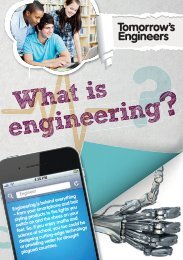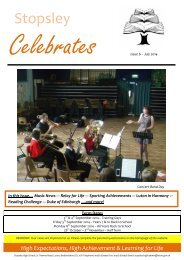177447-agenda-summer-2014
177447-agenda-summer-2014
177447-agenda-summer-2014
- No tags were found...
You also want an ePaper? Increase the reach of your titles
YUMPU automatically turns print PDFs into web optimized ePapers that Google loves.
COMMENTWHAT’S THE FUTUREFOR THE REFORMED ‘AS’?PAUL STEER, OCR DIRECTOR OF POLICY AND STRATEGY,CONSIDERS THE ISSUECome September 2015, teachers will bedelivering the first batch of reformed,linear A Levels. The new AS is a ‘decoupled’qualification that can be taken part waythrough an A Level programme but whichwon’t contribute to the final A Level grade.People have begun to ask questions aboutthe purpose of the new AS – is there reallyany point in students taking it? The jury isstill out on this one. Talking to teachers and awide range of stakeholders reveals that mostpeople remain undecided. There is a strongelement of ‘wait and see’, and this is probablythe right view to take – the arguments forand against are finely balanced.Co-teachability is one of the issues thatmany are attempting to grapple with. Theregulator has made a co-teachable AS arequirement. This means that the same classof pupils can be taught both the AS and theA Level in their first year, with the AS beingthe point of termination for some pupils,while others go on to take the full A Levelat the end of their second year. Superficially,this looks like business as usual but thelinear nature of the A Level introducessome important structural changes. The ALevel syllabus covers two years’ worth ofstudy time and anything learned in thosetwo years may come up in the final exams.This means that content studied for theAS may be assessed again in the A Level.Furthermore, the AS is notionally set at aslightly lower level of demand, designed forpupils who have only been studying for oneyear. In other words, the new A Level is nolonger a game of two halves.The challenge of teaching two terminalexams side by side with different pointsof termination will be greater for somesubjects than others. The best way to thinkthis through is to review the exam boards’draft syllabuses for AS and A Level, to lookat how they have structured the content,and the advice and guidance provided.Of course, there are others who neverliked the AS in the first place. They accuseit of wasting valuable teaching time withexams and revision. They also believe thatthe ‘modular’ nature of the current A Levelscompartmentalises learning into silos thatlimit pupils’ opportunities to make linksbetween topics across the whole syllabus.Measuring progress is another issue. Pupilsand teachers like to do this. So do thepeople who manage the teachers. The AShas become an important measurementpoint. The reliability of AS as a predictor ofA Level performance is very high, but thisis not surprising when it comprises 50% ofthe final A Level grade. The correlation ofperformance between AS and the linear ALevel may prove less reliable.The AS is often cited as a powerfulmechanism for building confidence.Students who are unsure about a subjectbecause they perceive it as challenging(eg physics), or have not studied it before(eg psychology), may be persuaded totake it because they have the option of‘giving it a go’ for a year. The NUS/OCRsurvey of students (see page 12) reveals53% of A Level Physics students do justthat. Worryingly, the survey also suggeststhat the role of AS in boosting confidence ismost critical for those students who live inareas where few young people progress touniversity.So long as universities use AS results toinform admissions, it seems inevitablethe AS will continue to be taught. As theHE ‘market’ evolves however, there maybe increasing disparity between entryrequirements. Under the new process, thenumber of UCAS points an AS attracts willgo down – to less than half an A Level.Some have interpreted this as a sinistersignal from HE but it is probably just theresult of applying the formula.Universities have been outspoken insupport of retaining AS in its current‘coupled’ format. Its reliability as a predictorof final grades is valued, as is evidenceof its contribution to social mobility andaccess. But the imperative to offer equalityof access could become problematic.Universities will have to consider how totreat applicants fairly who have attendedinstitutions that no longer offer the AS.The current AS extends breadth by allowingfour subjects to be studied in the firstyear, giving students the opportunity toexplore a wider range of disciplines thanmight otherwise be the case. Even withthe current AS, A Level programmes arerelatively narrow and specialist whencompared with the broader baccalaureatestyleapproaches in other parts of theworld, so people need to think twice beforeditching the AS if that means narrowingthings down to three subjects.If an institution decides to withdraw or limitAS availability, what could it do with the spaceleft on the curriculum? Could a refreshed andmore inclusive Extended Project Qualificationoffer a new kind of breadth – especially if itwere brought forward a year? Could CoreMaths offer something vital to students whohave selected largely arts-based subjects?What about activities that take people intothe community? And surely it is time to lookat the extensive vocational provision on offer,especially with newly established governmentpolicies which have brought in new TechLevels and Applied General qualifications.Now is the time for each institution toconsider carefully what its curriculum offershould look like, to study the new draft ALevel syllabuses and other qualificationson offer, to keep one eye on the moneyand funding, and the other on universityadmissions policies, whilst all the timebearing in mind the impact of the changeson young people and the decisions theymight take.Email your comments to <strong>agenda</strong>@ocr.org.uk14 OCR AGENDA Summer <strong>2014</strong>




